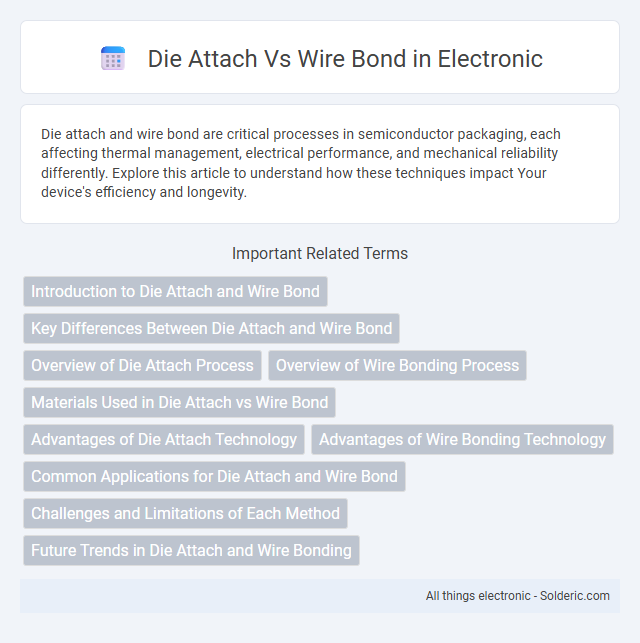Die attach and wire bond are critical processes in semiconductor packaging, each affecting thermal management, electrical performance, and mechanical reliability differently. Explore this article to understand how these techniques impact Your device's efficiency and longevity.
Comparison Table
| Aspect | Die Attach | Wire Bond |
|---|---|---|
| Definition | Method of attaching semiconductor die to a substrate using adhesive materials. | Technique connecting semiconductor die to lead frame using fine metal wires. |
| Primary Function | Mechanical and thermal attachment of die. | Electrical connection between die and package. |
| Materials Used | Epoxy, solder, or conductive adhesives. | Gold, aluminum, or copper wires. |
| Thermal Performance | High thermal conductivity for heat dissipation. | Limited thermal conduction. |
| Manufacturing Complexity | Relatively simple process. | Requires precision and controlled environment. |
| Cost | Generally lower cost. | Higher cost due to wire materials and tooling. |
| Reliability | Strong mechanical bond; influenced by adhesive quality. | Susceptible to wire breakage and bond lift-off. |
| Applications | Used mainly for die mounting in IC packaging. | Used for interconnects in integrated circuits and microelectronics. |
| Typical Thickness | 20-100 micrometers. | Wire diameters range from 15-100 micrometers. |
Introduction to Die Attach and Wire Bond
Die attach secures semiconductor chips to substrates using conductive adhesives or solders, ensuring thermal management and mechanical stability. Wire bond connects the chip's bonding pads to external circuitry with fine metal wires, facilitating electrical signal transmission. Both techniques are crucial in microelectronics packaging, impacting your device's performance and reliability.
Key Differences Between Die Attach and Wire Bond
Die attach and wire bond are two critical semiconductor packaging techniques with distinct functions and processes. Die attach involves securing the semiconductor die to the substrate or lead frame, primarily focusing on mechanical stability and thermal conductivity, using materials like epoxy, solder, or conductive adhesives. Wire bonding connects the die pads to external leads via fine wires such as gold or aluminum, ensuring electrical connectivity and signal transmission within the package.
Overview of Die Attach Process
The die attach process involves securing the semiconductor die to the package substrate or lead frame using conductive or non-conductive adhesives, solder, or sintering materials to ensure mechanical stability and optimal thermal and electrical conductivity. This process directly impacts device performance, reliability, and thermal management by establishing a solid bond between the die and the package. Precise control of temperature, pressure, and alignment during die attach is critical to avoid voids, delamination, and stress that can degrade semiconductor functionality.
Overview of Wire Bonding Process
Wire bonding is a widely used semiconductor packaging technique that involves connecting the integrated circuit die to the package leads using fine metal wires, typically gold or aluminum. This process employs ultrasonic or thermosonic energy to form reliable electrical and mechanical bonds between the wire and the bonding surfaces. Wire bonding enables high-density interconnections with precise placement, making it essential for complex microelectronic assemblies.
Materials Used in Die Attach vs Wire Bond
Die attach typically involves conductive adhesives like silver-filled epoxies or solder alloys that provide strong mechanical support and efficient thermal conduction between the die and substrate. Wire bonding uses ultra-fine gold, aluminum, or copper wires to electrically connect the die to the package, optimized for electrical performance and flexibility. Your choice between these materials depends on the application's thermal, mechanical, and electrical requirements.
Advantages of Die Attach Technology
Die attach technology offers superior thermal conductivity and mechanical stability compared to wire bonding, enabling enhanced heat dissipation and reliability in high-power semiconductor devices. The direct attachment of the die minimizes electrical parasitics, resulting in improved signal integrity and higher frequency performance. This method also provides better resistance to vibration and mechanical stress, making it ideal for automotive and aerospace applications.
Advantages of Wire Bonding Technology
Wire bonding technology offers superior flexibility and cost-effectiveness compared to die attach methods, enabling efficient connections even for complex integrated circuits. Its compatibility with various materials and fine pitch capabilities enhances circuit density and reliability in semiconductor packaging. Choosing wire bonding for Your assembly ensures precise electrical performance and streamlined manufacturing processes.
Common Applications for Die Attach and Wire Bond
Die attach is widely used in power devices, LEDs, and RF modules where thermal management and mechanical stability are critical. Wire bond is common in microprocessors, memory chips, and sensors due to its flexibility in connecting small, intricate circuits. You should choose die attach for robust mechanical support and wire bond for precise electrical interconnections in semiconductor packaging.
Challenges and Limitations of Each Method
Die attach faces challenges such as thermal management issues and potential delamination under mechanical stress, limiting reliability in high-power applications. Wire bonding encounters limitations with fine pitch wiring complexity and susceptibility to wire sweep or breakage during packaging, affecting yield and performance. Your choice should consider these factors to optimize device durability and manufacturing efficiency.
Future Trends in Die Attach and Wire Bonding
Future trends in die attach and wire bonding emphasize the integration of advanced materials like silver sintering pastes and ultra-fine wire technologies to enhance thermal conductivity and electrical performance. Innovations in automation and machine learning are driving greater precision and throughput in manufacturing, reducing defects and improving overall reliability. Your electronics can benefit from these advancements, which support miniaturization and the growing demand for high-frequency, high-power devices in automotive and 5G applications.
Die Attach vs Wire Bond Infographic

 solderic.com
solderic.com